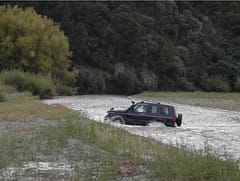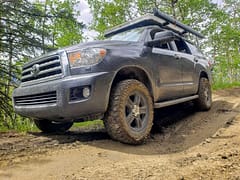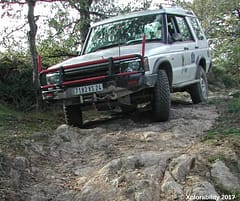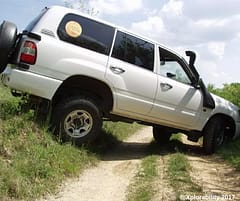Gravel and Country Roads Driver Training Techniques
Defensive Driving on Gravel
Contents
- Introduction
- 10 Points to Consider While Driving Gravel Roads
- Four Wheel Drive or Two Wheel Drive?
- If You Loose a Wheel Off the Edge
- Back Country Gravel Roads
- Irregular Curves
Introduction
In many Countries rural areas are a large part of the road network and consists of low surface grade or gravel roads. The reason for this is that tarred roads are expensive to build, and are not particularly necessary if they don’t carry a lot of traffic. Gravel roads are inexpensive and easy to maintain. The only drawback is that people who use them have to drive slower and need to use a slightly different set of driving skills.
Most vehicles operators and handbooks explain how to drive on gravel roads. Unfortunately, many drivers don’t bother to listen or read the information available, and so every year a number of people cease being travelers and become statistics.
This content was developed by and owned by Paul Sinkinson, Xplorability owner. Paul is a 4wd Defensive Driver Training Consultant/Trainer and Programme Developer.
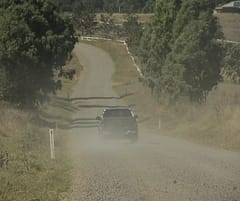
10 Points to Consider While Driving Gravel Roads
-
Excessive speed is the Major cause of accidents on gravel roads. It is highly advisable to keep to below a Maximum speed limit of 40 km/h. Lack of concentration is the second main cause, due to long driving distances and very little traffic.
-
Pay attention to road traffic signs. Particularly those that indicate a gentle or sharp turn ahead. You should reduce your speed accordingly.
-
Switch on your headlights in dusty conditions so that other road-users can see you.
-
Reduce speed when passing oncoming traffic and keep to the right side of the road as far as safely possible.
-
Tyre pressure plays an important role in the road-holding ability of your vehicle. Stick to the recommended pressures at all times. Check your tyres and tyre pressure every day.
-
Avoid driving at night. It is dangerous due to poor visibility and movement of the local wildlife
-
In rainy or wet conditions beware of slippery roads, wash-aways, and running water.
-
Always be on the lookout for wild animals and slow down immediately when you see them.
-
Keep both hands on the steering wheel at all times.
-
Always sit correctly in the driver’s seat when driving.
If you have a problem on a Rural Road, especially if you require vehicle recovery or repairs, you may need water as you wait for someone to come along. As a rule have a minimum two litres for each occupant and two litres for the radiator.
Here are some serious guidelines for driving on gravel. Use them and you could possibly save your life and the lives of other road users as well as minimizing vehicle damage.
I will not apologise for the fact that I may repeat certain points. I have done this in the hope that the information is taken in, absorbed and more importantly, retained. It may save your life and the lives of others.
Four Wheel Drive or Two Wheel Drive?
Many vehicles today are permanent Four Wheel Drive with traction control and this does help with traction and stability on loose gravel surfaces. However, some still have the 2wd and 4wd facility. On loose surface gravel roads it is always advantageous to engage four wheel drive as this will provide better directional control. That said, do not be lulled into a false sense of security.
-
You may be in a hurry to get where you are going, but speeding is particularly dangerous on a gravel road (Rural and Forest Roads). The speed limit on a gravel road needs to be a leisurely 40 km / hour Maximum. Of course, there are exceptions such as the long distance unsealed roads in Australia where speed limits may be reconsidered and be higher BUT BE WARNED – Excessive Speed and lack of concentration on them will and does cause accidents.
-
ONLY When you have a clear view of the road ahead, Drive as close as possible to the center of the road. This will give you time to react. Slow down and move to the correct side of the road when a car approaches. Move to the correct when approaching Blind Crests. Roll your windows up to avoid being sandblasted.
Drive at a safe speed with mechanical sympathy
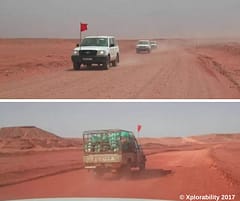
-
Occasionally someone will want to overtake you. When this happens, slow down and move safely to the correct side of the road. This will reduce the damage done to your car by stones that the overtaking vehicle throws up. Your visibility will be substantially limited by the dust of the overtaking vehicle, so, drive slowly until the dust trail subsides.
-
Keep an eye on the sides of the road for people and animals. Slow down if you see either. Animals are particularly dangerous. You don’t know if it they will jump out into the road in an attempt to get over before you arrive or if they will stay put.
If you slam on brakes, (vehicles without ABS) the car could skid and result in a rollover. Use your brakes gently. In a crisis try to pump the brakes gently and continuously. For vehicles with ABS the system should maintain directional stability
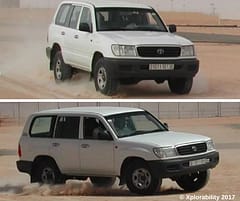
-
If it is dusty, hazy or raining, turn your headlights on so that other drivers can see you.
-
Keep an eye out for traffic signs, especially the signs for curves and sharp turns. When you see a turn or curve, you will have less road holding to work with if you encounter one of these, so slow down. The gravel tends to be pushed to the edges of the roads building up loose areas that can cause you loss of control.

-
Take extra care when you drive gravel roads in the very early morning or at night. Visibility is poor and animals will be on the move.
-
Slow down if it rains. The surface becomes slippery, roads get washed away in places and puddles may conceal holes that you would otherwise have avoided.
-
Check that your tyre pressures are at the recommended pressure. Check daily if possible. Tyre pressure plays an important role in the road-holding ability of your vehicle. Make sure at you have at least one spare wheel/tyre before setting off.
-
If you have a problem, you may need water as you wait for someone to come along. As a rule have a minimum of two litres for each occupant and two litres for the radiator.
-
When passing someone… make sure that the road ahead is clear of other oncoming vehicles and that there are no blind crests ahead and that you build up some distance before you turn in again. The stones that you throw up may break his windscreen. Slow down and drive to the middle of the road if you see pedestrians, cyclists, donkeys/horses or carts. The stones could damage them as well. Keep both hands on the wheel at all times.
-
Concentrate.
Remember – Your safety and the safety of others depends on You!
This Driver was not concentrating – Perhaps he was talking with a passenger or on his mobile phone. He lost a wheel over the edge of the gravel road, turned to regain the road and braked at the same time. The weight transferred to the front – He lost control and the vehicle overturned.
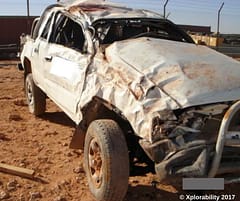
If You Loose a Wheel Off the Edge
- Take your foot off the accelerator pedal
- Do not brake hard with the foot brake, let the engine braking slow you down
- Do not try to swerve back on the road - If you swerve the weight transfer may roll over the vehicle
- Continue to drive in a straight line - assuming it is not dangerous
- As the vehicle becomes stable in a straight line - gently apply braking
- Stop in a safe position and check for damage before continuing journey
Back Country Gravel Roads
Gravel roads are a fact of life for drivers in many Rural Areas. But, Urban Site, Gravel and any Sand or Desert roads present their own special road safety challenge. The issue is traction. Driving on loose gravel is harder than driving on Black Top because your tyres don’t have the traction needed to give you stable control. Throw speed into the mix, and you have a formula for trouble.
Construction materials, weather, traffic volumes, and vehicle weights can change a gravel road’s condition very quickly. That’s why it’s so important to approach gravel roads with caution each and every time you encounter one. It may not be the same road you traveled this morning. There are specific driving behaviours you can adopt that can help decrease your risk.
- Leaving a paved Black Top surface for a gravel one. The first thing to remember is to slow down. Your vehicle is going to handle differently when it moves from one surface to another. The gravel may be loose, or it may be hard-packed; you want to know how your car handles before driving any distance.
- Avoid sudden changes in direction, such as a swerve to avoid an object or animal on the road. Swerving can be particularly dangerous on loose gravel or at excessive speed.
- Stopping or speeding up too quickly. Always drive at a speed that allows you to stop easily for any hazard. Accelerate and brake slowly, and reduce your speed when approaching blind intersections, bushes and hills. Be considerate, too. As you approach other vehicles, slow down and move over to the right so you can pass each other safely and avoid stone chips.
- Stay back and keep a good following distance. Even if the visibility is good and the road is hard-packed, stay at least 10 seconds behind other vehicles. Increase this distance when conditions are less than perfect. This reduces the danger from a cloud of dust obscuring vision or flying rocks damaging headlights and windshields.
- Stay on the tracks. If you’re the only one on the road, drive in the tyre tracks that exist. If you have good visibility of the road ahead, even if the tracks are in the centre of the road, it’s safer to drive in the tracks than to be too close to a deep ditch, drop off or a soft shoulder. Of course, always scan ahead for oncoming traffic, and move to the right if a vehicle is approaching.
- Rollovers. It’s easy for a distracted driver to allow the tyres on one side of the car to wander off the road while traveling at higher speeds. Don’t turn the steering wheel and jam on the brakes. This can cause the car to start into a sideways skid, where it may tip and roll over several times before stopping. If the tyres on one side of the vehicle go off the road, don’t immediately turn the wheel to try to get back on the road. Many of the Gravel Roads have large drop offs. Lift your foot off the accelerator pedal and steer the car in a straight line and let the vehicle gradually come to a halt then continue slowly and return to the road surface.
- Be ready for skids. A vehicle can become difficult to handle in heavy gravel. If the vehicle starts to skid, remove the cause of the skid by releasing your accelerator or brakes. As you release them, look where you want to go, steer the vehicle in this direction.
- Remember, too, that the MAXIMUM speed limit in ideal conditions is 40 kph unless otherwise posted.
You can, with regular practice, find a suitable “Harmonic” speed to suit your vehicle for this type of surface. At that speed, the vehicle suspension movement becomes minimal which in turn allows a more comfortable ride. Be warned though that this speed may increase the likelihood of a loss of directional control on extremely loose surfaces especially on corners.
Irregular Curves
Have you ever wondered why you slide out so easily when cornering on Gravel roads?
Dirt and paved road curves differ significantly, and that has nothing to do with size and surface. This has to do with how they are constructed.
Paved roads are laid out with circle-drawing compasses. That doesn’t mean they are circles, but it does mean that they are regular curves. When you enter a paved curve and give the steering wheel a “set,” the road more or less holds constant. Paved curves almost always go from straight, transition to a fixed, regular curve, then straighten out again with no irregularities in between. This makes for easier and safer driving.
Dirt roads usually follow the Natural Contours of the land. This leads to irregular curves. Irregular curves mean the radius varies: They may get tighter and tighter, or straighten out faster than expected. That may be the reason we unexpectedly have a vehicle slide because it isn’t exactly what we were expecting.
IMPORTANT! Not all gravel roads are the same. Please be aware of the road conditions and adjust your driving style accordingly
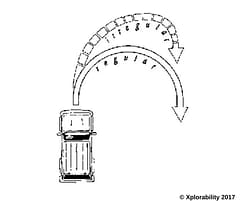
Why does this happen? Similar to the asphalt top course on paved roads, gravel is the “wearing surface” of an unpaved road. The large stones, in contact with each other, distribute vehicle loads to the road base beneath it. The stones are held by smaller particles, especially “fines.” With insufficient fines, vehicle tyres more easily move the stones. As their particle-to-particle contact decreases, so also does their ability to distribute loads.
In addition, continuing traffic begins to move the stones into the pattern of ridges and valleys. Traffic causes corrugations in two ways:
- The force of the tyres and the road surface,
- The motion of vehicles bouncing ups and down on their springs and tyres.
The degree of damage depends on tyre hardness and vehicle acceleration, deceleration, turning, and speed. Because hard tyres excert greater force per square inch on the road surface, they break and scatter aggregate more than do soft tyres. Acceleration, deceleration, and turning also increase tyre-to-road surface forces. Therefore, corrugations usually occur first at road and driveway intersections, and at tops and bottoms of hills.
High speeds increase both tyre force and bouncing. Fast moving vehicles, therefore, quicken the formation of corrugations and increase their depth.
These factors have the greatest effect on roads with a weak base, poor drainage, or both. A weak base deflects under loads, and becomes deformed into the same wave-like pattern as the surface. Poor drainage leaves water in the road, or allows it to percolate in from the sides. Too much water lubricates the base and surface particles. Thus, water increases particle movement, and corrugation formation and depth. These Corrugations can be found anywhere on the road but more often in areas where vehicles slow down or accelerate. IE: Junctions, turns and curves, hill crests and the base of hills on the route.
Remember, Reduce your Speed … .
Drive with mechanical sympathy!
Previous Article: Uphill and Down Dale
Next Article: On-Road Rollovers
Copyright
This content was prepared for the Off-Road Discovery Website by Xplorability 4wd Training
The Content - All Photographs and Photographic Copyright and All other Rights other Reserved October 2017. S.W. France This content may not be copied or reproduced without the written consent of Paul Sinkinson – Xplorability Training.
For Use Only in 4wd and Light Vehicle Driver Training.
Not for Re-Publication, Distribution or use outside the Xplorability Training Programme
